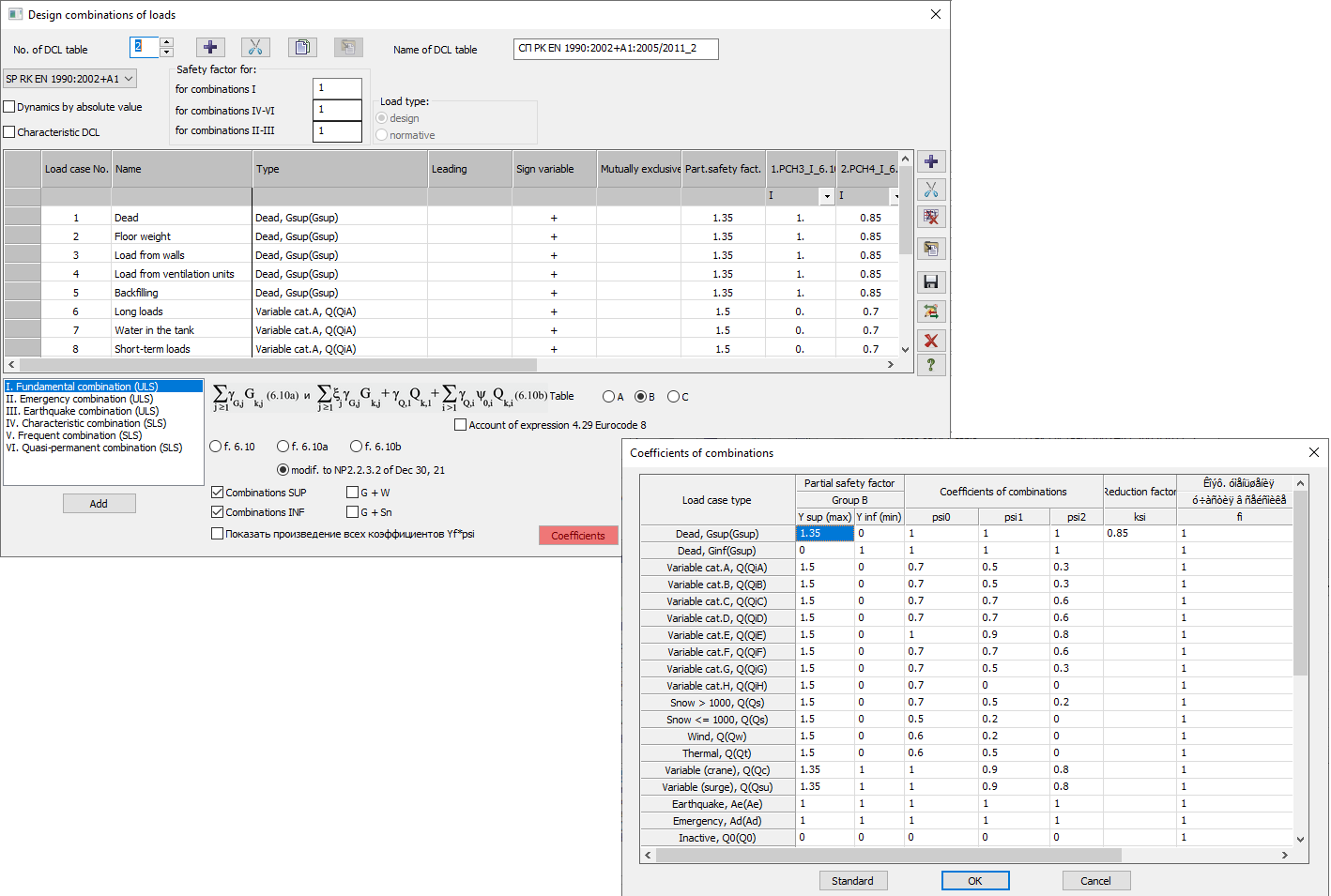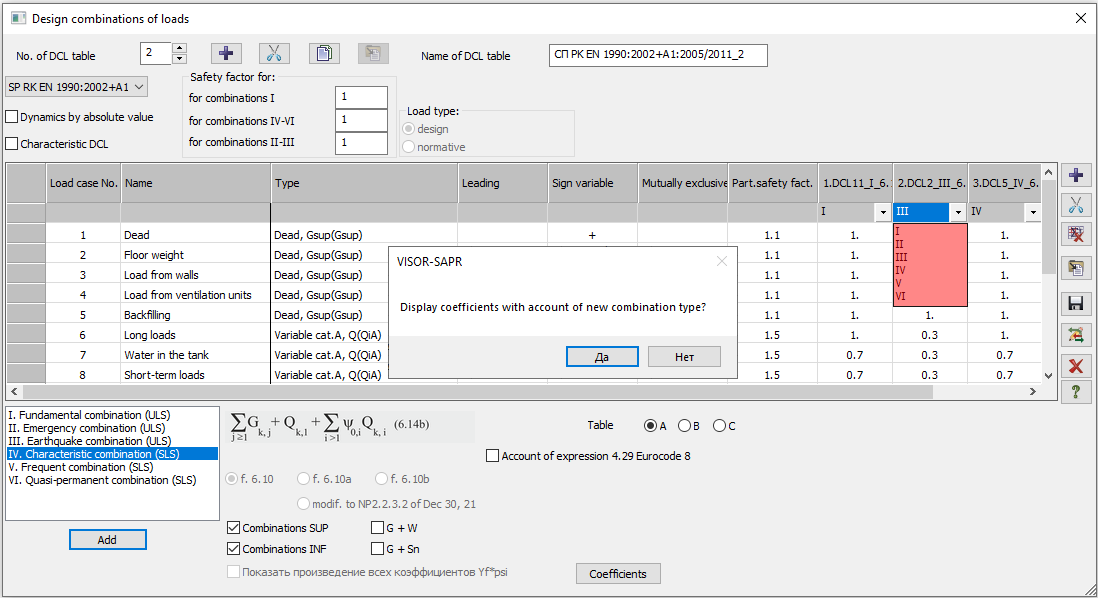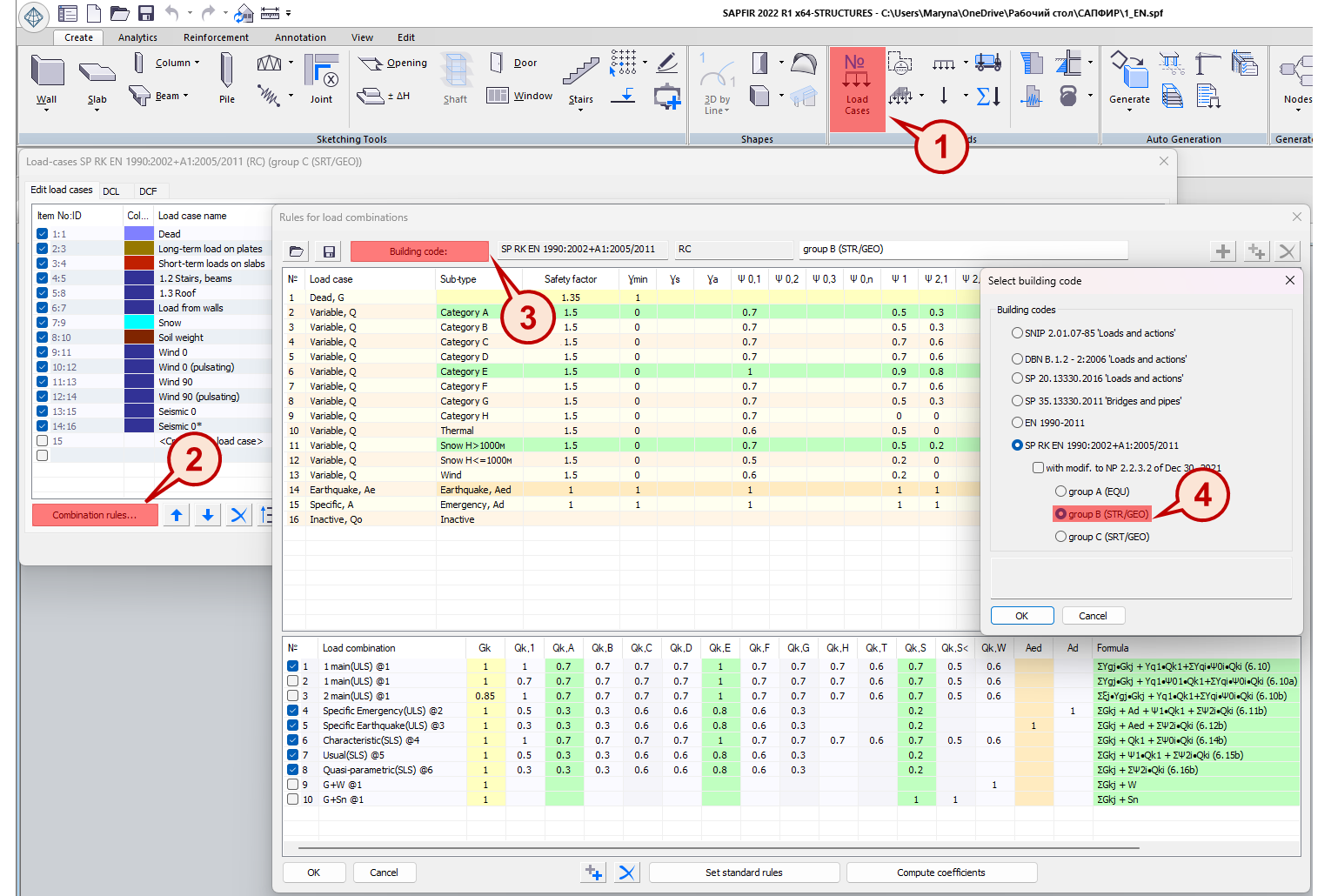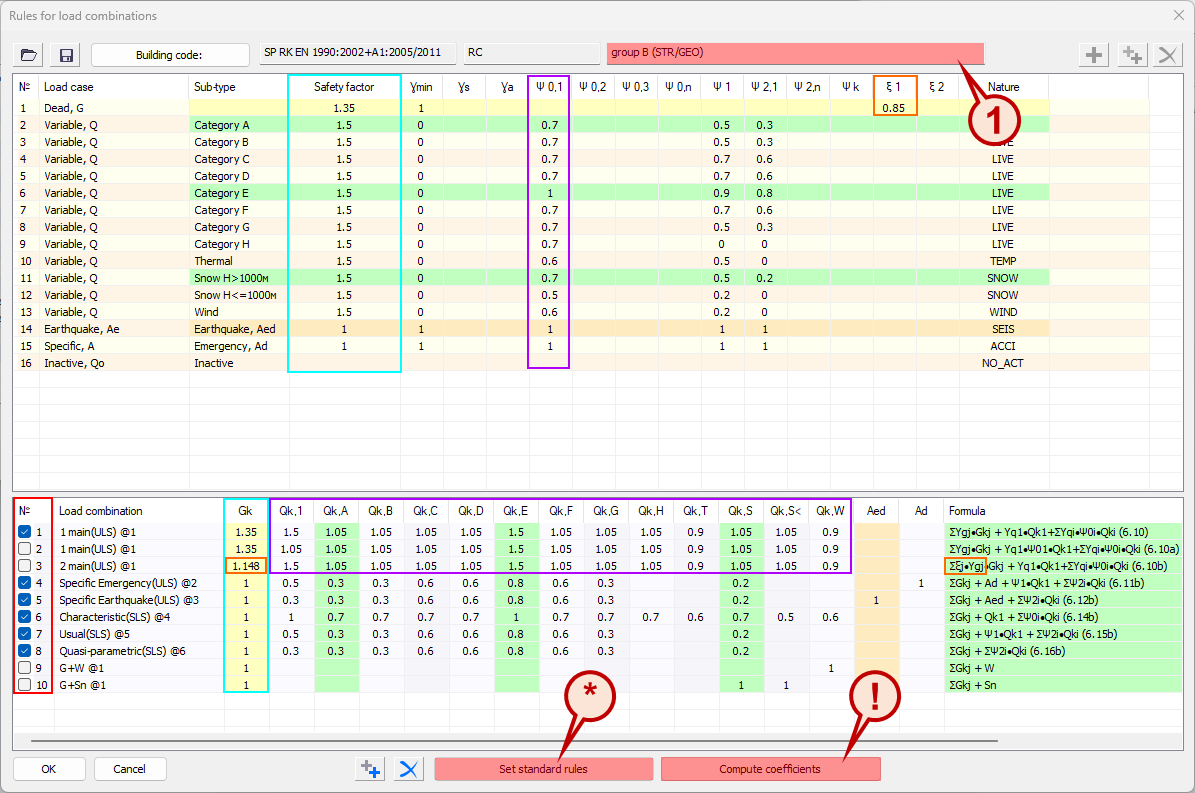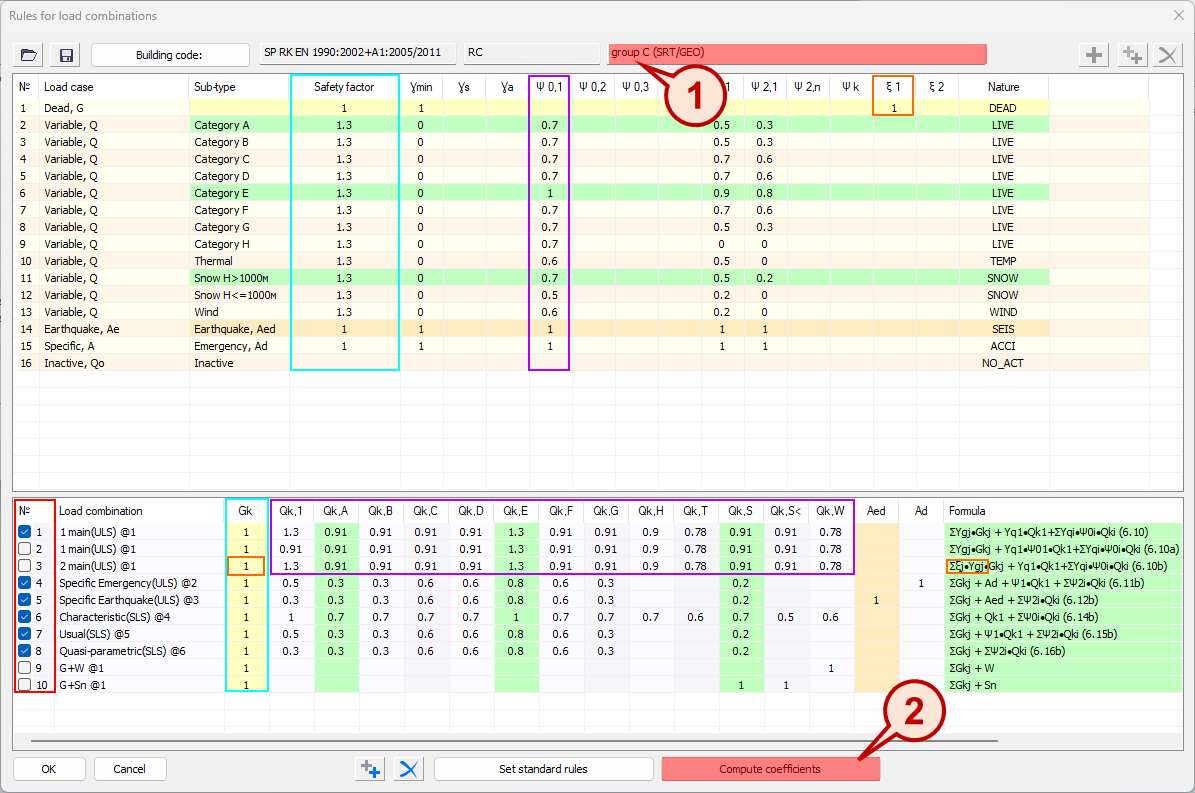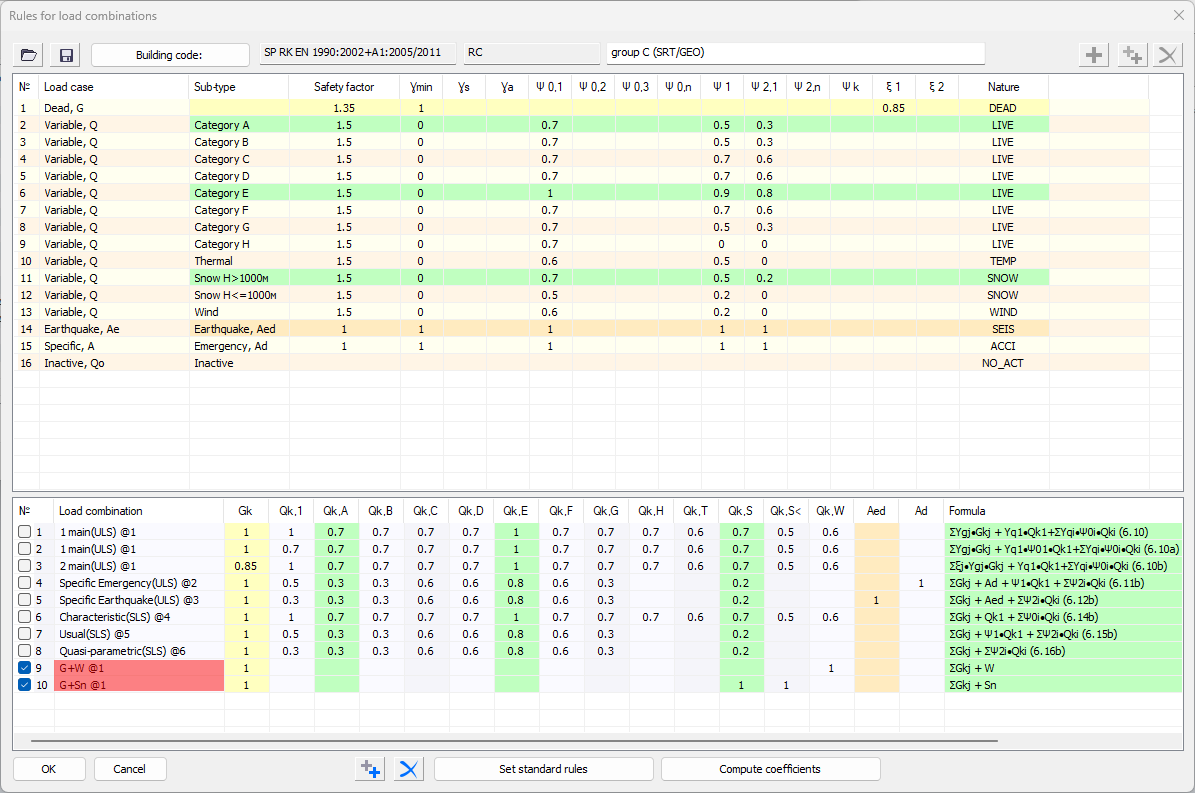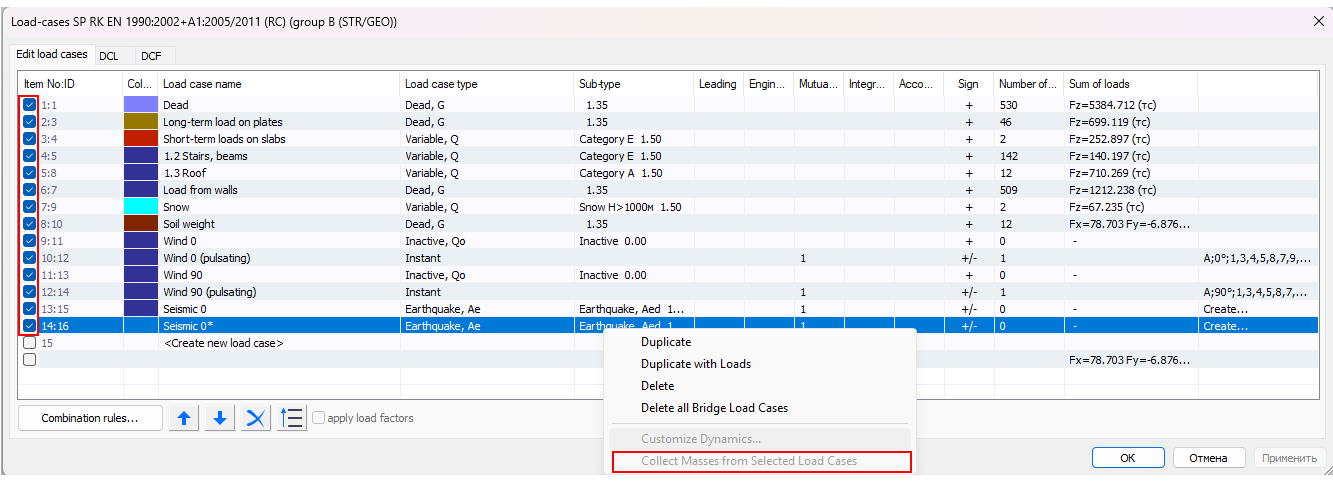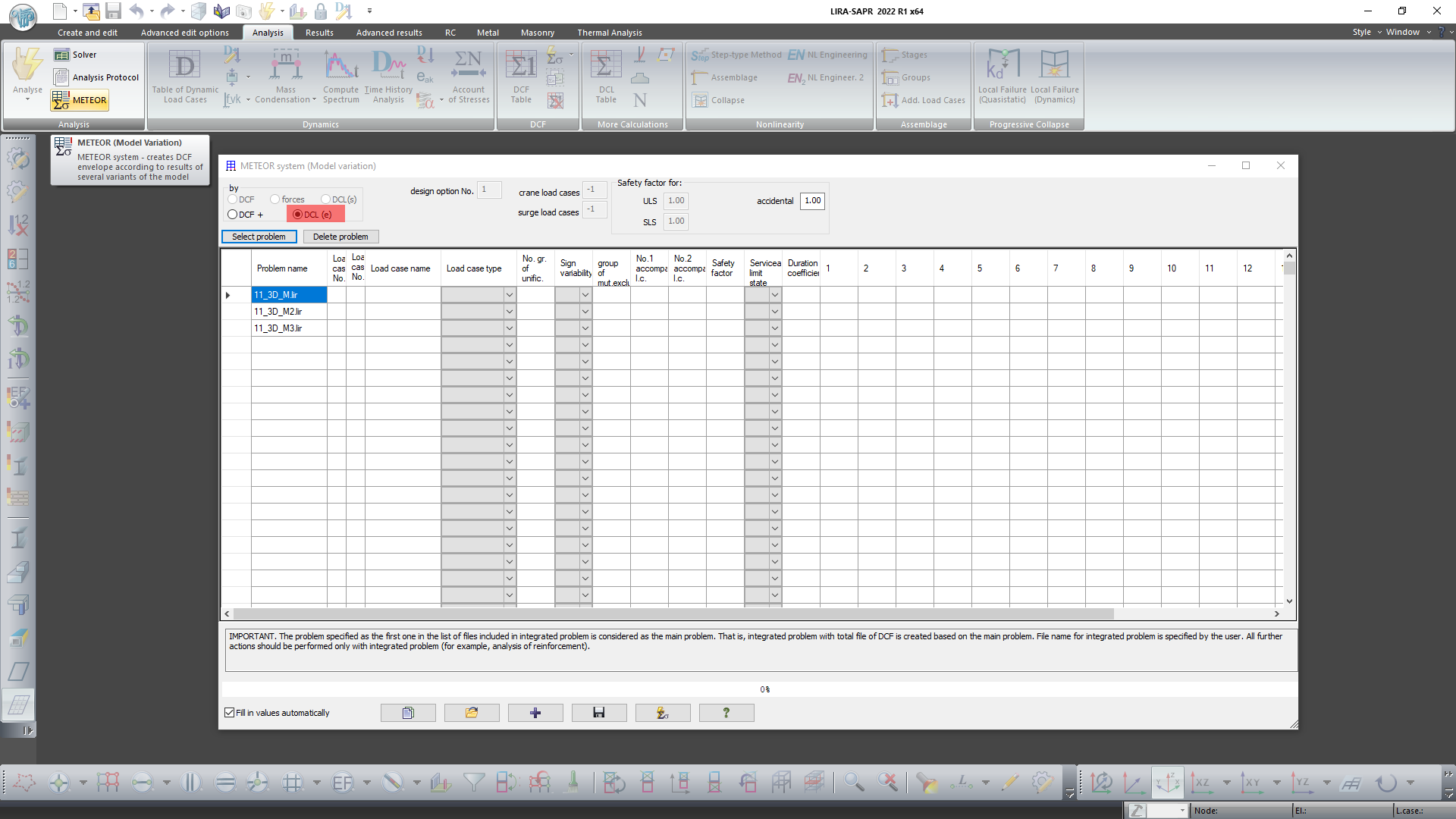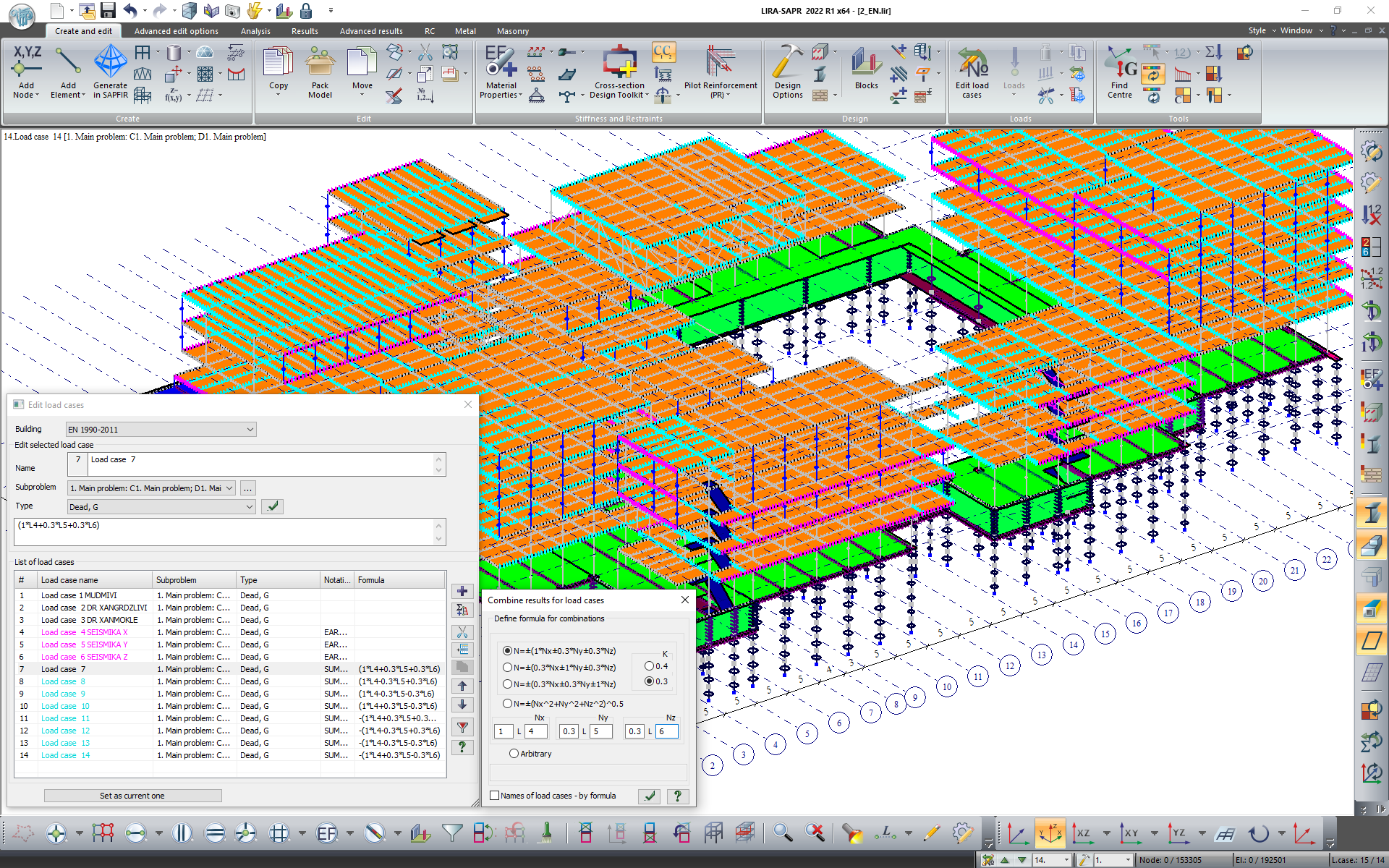Eurocode 0. Basis of structural design
LIRA-FEM* software supports a variety of national building codes, as well as European standards (Eurocodes) and national annexes to Eurocodes for Ukraine, the Republic of Kazakhstan, and the Republic of Belarus.
Eurocode 0. Basis of structural design
In LIRA-FEM (LIRA-SAPR) program, it is possible to apply various types of loads to nodes and elements of design model:
- Nodal loads - forces and moments along the direction of global and local coordinate axes of the node, forced displacement and rotation.
- Loads on finite elements - uniformly distributed loads, trapezoidal loads, forces and moments with snaps, thermal heating, temperature difference, non-uniformly distributed loads on plates, loads on plate rib, loads on solids and their faces, arbitrary surface loads on plates.
- Loads to simulate dynamic actions - mass weights along the direction of global and local coordinate axes for node, mass weights distributed to finite elements, static loads automatically converted into loads for dynamic actions, impulse and impact loads, harmonic vibrations, static wind loads for wind pulsation analysis, real and synthesised earthquake accelerograms.
- Super-loads - loads on super-elements. Loads for time history analysis. Loads for generation of influence lines.
To ensure the relationship between the analysis results of the structure (for various loads) and the design of its elements, it is necessary to compute the most dangerous combinations of loads. In general case, the total number of load combinations may reach the number 2n , where n-number of applied loads. It is assumed that linear analysis of the structure was carried out. In practice this means that it is necessary to find 2n of the stress-strain states for the structure, and this is unacceptable even with powerful computing resources. With a comparatively small value of n, it becomes difficult to achieve a result, and the volume of the result becomes boundless. This raises the following problem: to find a criterion to limit the number of load combinations under consideration to the number m (m << 2n ). Design based on m combinations would have to provide the strength of the structure for all 2n combinations. Various approaches are applied to solve this problem. One such approach is based on the calculation of design combinations of loads (DCL) and forces corresponding to them according to formulas stipulated in certain standards. This approach is adopted as the main one in Europe and the USA. It results from a probabilistic estimation of the contribution of a certain load to the resulting stress-strain state of a structure. The same limited number of combinations is considered for each structure. It should be noted that this approach can also be applied to nonlinear problems, although, due to the unfairness of the superposition principle, the problem of load combinations develops into the problem of design combinations of loading histories.
The DCL system is used to calculate nodal displacements and forces (stresses) in element from standard and arbitrary linear combinations of loads. Standard linear combinations are considered to mean combinations stipulated by formulas of normative documents. The sign variability and mutual exclusion are considered. For arbitrary linear combinations, the values and signs of coefficients are not limited.
The DCL system implements different building codes, including Eurocode:
- EN 1990:2002 Eurocode 0. Basic of structural design;
- SP RK EN 1990:2002+A1:2005/2011. Fundamentals for design of load-bearing structures;
- TKP EN 1990-2011 (02250), STB EN 1990-2007.
According to Eurocode 0, the following limit states are considered:
- ultimate (combinations of loads indicated in expressions (6.10) - (6.12b) should be used in analysis by ultimate limit state);
- serviceability (combinations of loads indicated in expressions (6.14b) - (6.16b) should be used in analysis by serviceability limit state).
Combinations that depend on building codes
Notes
Notation: ULS - ultimate limiting state, SLS - serviceability limiting state.
The index 'k' in the above-mentioned formulas refers to the normative loads, without account of the safety factor.
*For ULS group of combinations. If the Fundamental combination is selected and group B is defined for analysis, then in VISOR-SAPR module, with the option buttons it is possible to indicate the number for the formula (formula 6.10, formula 6.10a, formula 6.10b), or define the option Modification to NP2.2.3.2 of Dec 30, 21. In the latter case, combinations will be generated in series by two specified formulas. For groups A and C, formula 6.10 is applied.
**The ψ1,1 combination coefficient is applied if one of the temporary load cases is denoted as Leading one. If more than one leading load case is specified, the program generates different sets of combinations where the specified load cases are alternately assigned as leading ones.
In EN 1990:2002 (and in all building codes similar to Eurocode), there are maximum and minimum load factors (safety factors). As a rule, the maximum value is considered because, in most cases, 'greater load = greater force'. But in some cases, a lower load does not lead to worse (for the structure) results. For example, in a overturning analysis, a larger static vertical load on the structure causes an increased holding (from an overturning) moment. This is another reason to define normative loads and, only at the combination stage, depending on the design purpose of the combination, apply higher or lower load factors or safety factors.
The Eurocodes (including the SP RK EN 1990:2002+A1:2005/2011) describe the combination coefficients (ψ) in several variants of values: ψ0, ψ1, ψ2.
1. DCL in VISOR module
To generate the fundamental DCL, in VISOR module, it is necessary to select the table (A, B or C). Depending on the selected table, it is possible to select a formula for the main combinations: for table A only formula 6.10 may be selected, for tables B and C any of formulas 6.10, 6.10a or 6.10b may be selected. It is also possible to generate combinations (separately) with the favourable and unfavourable loads. In accordance with SP RK EN 1990:2002+A1:2005/2011 (and in all building codes similar to Eurocodes), six types of DCL may be specified: fundamental, emergency, earthquake, characteristic, frequent and quasi-permanent. For the selected row of combinations, the corresponding formula and its number are displayed.
For fundamental combinations, depending on the selected formula (6.10, 6.10a or 6.10b), the formula and its number are displayed next to the combination list. Fundamental combinations may be specified only for one formula in one DCL table (in the LIRA-FEM program, it is possible to generate several DCL tables; analysis by these DCL may be carried out in different design options).
In the 'Leading' column, you can use the '*' symbol to specify the loads that should be leading ones. When generating the DCL, all possible combinations with the specified leading loads will be automatically created (one combination may include only one leading load).
A combination type (l to Vl) is assigned to each column of combinations. It is possible to change this type for any column of combinations. Upon request, the program may re-fill the combination coefficients to take account the new type of combination.
Double-click the name of the combination column to open the 'Name of DCL' dialog box. In this dialog box, you can change the name of the combination (by default, the number and type of the combination are assigned as the name). For combinations generated for the serviceability limit state, you can select whether these combinations can be used (1) in all analyses by the serviceability limit state, (2) only for analysis of cracks in reinforced concrete elements, or (3) only for calculation of deflections in metal elements.
In DCL according to building codes similar to Eurocodes (including SP RK EN 1990:2002+A1:2005/2011) - each combination has a different purpose. Thus the result of the calculation by DCL table is a single table indicating the purpose of every combination (in our case the Roman values from I to VII).
2. DCL in LIRA-CAD (SAPFIR)
In LIRA-FEM program, in the LIRA-CAD, the process of specifying combinations according to SP RK EN 1990:2002+A1:2005/2011 is enhanced:
- subnatures of temporary load cases are added to realise different combination coefficients according to different categories of premises;
- defaults are filled in according to the selected calculation group (A, B, C), 'group B' is suggested by default;
- the rules for creating combinations are described (formulas 6.10 to 6.16).
IMPORTANT: It is assumed that normative loads are specified in the meshed model and they are not multiplied by the safety factor when transferring to VISOR module for analysis. The normative load becomes 'design load' by multiplying it by the combination coefficient and the safety factor. Thus, in the FEM model (VISOR) we also have normative loads, and only by the results of the DCL calculation the forces become design loads in the required combinations.
With account of the default values (or with account of user modifications: both the safety factor and any of the combination coefficient may be changed), when you press the Compute coefficients (!) button, the values Y*ψ are multiplied and the program will fill in the bottom table of combination coefficients for loads of all subnatures/categories that will be used in combinatorics later. When you press the Set standard rules button (*), the default values will be displayed.
If the tables are modified, it is necessary to use the 'Compute coefficients' button to recalculate the coefficients that will be used in the combinatorics later.
In the bottom table on the left you can select or clear the check boxes - by which formulas to create (generate) combinations. By default, positions 2-3 (formulas 6.10a and 6.10b) are clear, and position 1 (formula 6.10) is selected.
Moreover, in LIRA-FEM, additional settings for automatic generation of load combinations are added to comply with SP RK EN 1990:2002+A1:2005/2011:
- combination 'G+W' - to create combinations with all permanent and one temporary load 'Wind'.
- combinations 'G+Sn' - to create combinations with all permanent and one temporary load 'Snow'.
Important. It is important to use these combinations in the analysis so that the framework is less load-bearing. This is especially necessary for the check by uplifting, overturning and for the calculation of anchors for foundations.
The ψ2 combination coefficients for the special combination are also the mass collection factors for the earthquake.
For the earthquake load (module 61) according to SP RK EN 1998-1:2004/2012 with a spectrum from NTP RK 08-01.1-2017, all parameters, including the CQC method of mode shape combination and the attenuation parameter to it (by default, 0.05), can be set at once.
If some loads were added when dynamic load was defined, use the right mouse button to refresh the list of loads for masses from the shortcut menu. In this case, all load cases checked in the first column of the table will be considered (loads 'wind', 'earthquake', 'emergency' are automatically excluded, even if they are also checked).
In this way it is possible to generate combinations based on accepted parameters and then modify something (the leading load case, the safety factors and/or combination coefficients, enable or disable some formulas for combinations in the lower table) and generate combinations once again - these modifications will be added to the already existing ones. That is, the previously defined combinations are not deleted.
3. How to merge the analysis results from several design models (METEOR system)
For the SP RK EN 1990:2002+A1:2005/2011, it is possible to use the METEOR system (problem integration), which is used to merge the analysis results of several design models with the same topology into a single integrated result. During the merge procedure, the DCL(c) results are unified: for all cross-sections from all problems, the program will select such DCL(c) that cause extreme value of each criterion. In this case, all DCL(c) for the corresponding criteria will automatically become mutually exclusive.
4. Creating combined load cases (load cases by formula)
In the LIRA-FEM it is also possible to creating new load cases as a combination of analysis results for an arbitrary set of other load cases. For such combination, in the 'Load Editor' the user defines mnemonic formulas where references to existing numbers of load cases are used as components, coefficients to these components and mathematical operations on them are defined. Load cases generated 'by formula' may be used in the generation of DCF/DCL and participate in the structural analysis. One example for the need of such a combination of results from different load cases is the requirement to take into account the multicomponent earthquake loads in the analysis by the linear-spectral method, as well as similar requirements of a number of national building codes of European countries (see, for example, Eurocode 8 'Design of structures for earthquake resistance', SP RK 2.03-30-2017 'Construction in seismic areas of the Republic of Kazakhstan').
Evaluate the software
If you have any doubt, download the Demo version and evaluate the program or contact our Support Team for more details.


